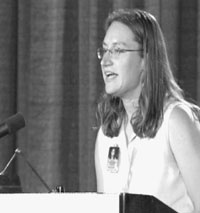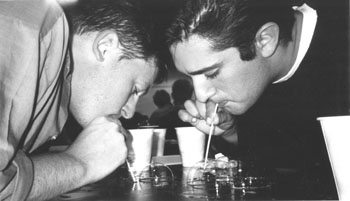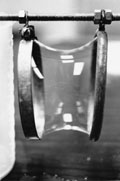|
|
|
 |
|
|
|
|
Learning the Science Of Pedagogy
by Riana St. Classis
|
|
 |
|
There is a special difficulty in writing about pedagogy, for its domain is inside the human mind. One can describe the objects used to facilitate it; one can describe the concepts at which particular pedagogies are driving; one can describe its effects; but, pedagogy itself can only be experienced as the reliving of a discovery. I have watched a group of 20-year-olds struggle, yawn, and sink ever further down in their chains, as if they were being swallowed into a pit of mud, sud enly become alive and animated as if a bolt of lightning went through the room, and, in a flash, reap the fruits of the tedious previous two hours labor, producing energy that would keep them going for the rest of the night in lively conversation, and the production of geometric constructions.
The electric moment when a young woman cries out: “Oh, that’s what the catenary has to do with LaRouche’s economics! It’s a principle of efficiency!” This is the mysterious moment of true pedagogy, of true communication. In that moment she seemingly spontaneously generates the idea that was the generator behind my organization of the pedagogical.
I could have told her, “The catenary, the form that a chain takes when it is suspended between two points, reflects the Principle of Least Action in the universe, and it is through the discovery of such principles that human beings increase their ability to survive on the planet, and this is real economics, LaRouche’s economics.” I could have said this, and it would have meant nothing. It required two hours of agony for us to have a meeting of the minds, and, after it occurred, infinite possibility opened before us, and no one noticed as the next four hours flew by.
|
|
|
|
|
|
 |
|
|
EIRNS
Riana St. Classis speaking at the Youth Panel of the September 2002 LaRouche conference.
|
|
Lyndon LaRouche recently wrote a paper, titled “The Pantheo-cons: The Weird Religions of Cheney’s Empire.”1 In this paper, he elaborates the particular political/cultural crisis we face at this moment, as a specific happening of universal history, using the specific to reveal the universal, general condition of man that this moment reflects. From this standpoint he defines the solution to the crisis, which is dependent on the development of an understanding and usage of a method of truthfulness, a method of knowing, by society or, at least, by a significant portion of society.
Within the first few pages, LaRouche identifies the critical, weakened condition of the minds of the population that allow the operations of a Rumsfeld and Cheney to occur. As LaRouche states in that paper, empiricism and the deductive method, based on arbitrary axioms and postulates, have been applied to religion, and have spawned the various fundamentalisms that run rampant in our society today. The religious fundamentalist’s irrational belief in the literal meaning of his religious text is essentially the same as the irrationalism of today’s scholars, in both the so-called humanities and hard sciences. The underlying belief is that we cannot know; we cannot know the intentions of either humans or the physical universe. All we can know is what is right in front of our faces.
As I began to understand what this meant, I comprehended what I had encountered in the various university departments in which I did time. What is taken for erudition in today’s Comparative Literature and English departments often amounts to a compulsive disorder, an obsessive fixation on word objects conceived as magic, as somehow powerful in themselves: You cannot know what the author of a text really meant when he wrote it. All you can know is words and how to manipulate them.
This is the same disorder that is revealed in the mathematics and science departments in their slavish obsession with equations and formulae, the true origin of which they are either ignorant or in which they are uninterested. For example, I never knew that quadratic equations were concerned with areas, with squares. Instead of knowing, I merely chanted the rules of operation, the deductive laws, like incantations.
It is this very fixation on sense-certainty, objects as such, that pedagogy undermines, as it directs attention toward the invisible, real universe. Like LaRouche’s writings, pedagogy is located in the specificity of history, for each discovery has been made by a unique human personality at a particular moment in time, while it simultaneously elaborates the universal reflected in the particular, and so reveals to us that which remains unchanged in the ever-changing universe.
Becoming Leaders
Etymological excursions are often used as diversionary tactics, to cover a lack of conceptual comprehension, but I hope to use etymology for the opposite effect, to aid me in unfolding what pedagogy is. The origin of the word “pedagogy” is the Ancient Greek word paidagogas, which is derived from the word for the slave (pais) who leads (agogas) the children (also, pais) to school, and then comes to mean the mode of instruction itself. We retain its implication of leadership. LaRouche’s youth movement goes into the marketplace, creating piecemeal extensions of the Platonic Academy.
Considering the derivation of pedagogy, think of us making ourselves slaves to the truth, and by so doing, making ourselves free. We are children who must lead, and we must make ourselves leaders. So, what we attempt with the pedagogicals is coherent with the Greek conception of education as shown in Plato’s Meno dialogue.
At Temple University, the LaRouche youth recently intervened in a speech by a professor, a follower of Leo Strauss, who was speaking on Plato, politics, and knowledge. A young LaRouche organizer questioned the professor about the discovery process of knowing demonstrated in the Meno. In the scene to which the organizer referred, Socrates goes through the process of leading a slave-boy to discover how to produce a square that is twice the area of a given square. Socrates says this is not a process of learning and teaching, but a process of reminding someone of something they already know.
Socrates speaks metaphorically, wittily reminding his listeners that a discovery takes place in the individual sovereign mind. You can lead a horse to water, but you can’t make him drink. The professor said this scene was merely “ventriloquism.” (In other words, the slave was incapable of making a discovery.) Another organizer objected, saying that he uses that same pedagogy all the time with people on the street, and he gets the same discovery every time. All human beings are capable of knowledge, and even a Straussian professor can make a discovery about the universe.
During the LaRouche political organization’s national conference on Labor Day 2002, one of the panel discussions presented LaRouche’s Youth Movement, and some of us were asked to speak. Sky Shields, a young man from Los Angeles, spoke about the hell of being a physics student imprisoned by arbitrary assumptions and the deductive method, unable to apprehend creativity as anything other than a random occurrence. After he spoke, he went to exit stage right, but found there were no stairs there. So Sky leapt from the stage, in a motion both graceful and carefree.
Afterward, one of the older members of the organization commented that in that moment he was struck: “My God, these are only children. We are going to be led by children.” Sky was nonplussed, for we do not seem children to ourselves. In the intervening year, I saw what this older member saw in Sky’s easy action. Like children, we become ecstatic when we discover, and usually, we are unafraid of playing. But we are, for the most part, undeveloped, unfamiliar with Beauty and classical culture, unfamiliar with what it means to make a discovery, and the true power of our minds. So, we are children leading children. We are developing the principle of leadership in ourselves as we are helping develop it in others.
|
|
|
 |
|
Jason Ross
Michael van der Nat (left) and Ali Razenagh experiment with soap bubbles at a California cadre school.
|
|
|
|
The first time I met Sky Shields, I had just turned 26 years old, and I was trying desperately to finally finish a bachelor’s degree. I had been invited to a weekend cadre school, a student conference, at a camp in Palm Springs, California. I was immediately struck by Sky’s patient and relaxed, yet extremely energetic, love for knowledge and for sharing that knowledge. I had spent nine years, and had attended four schools, in the course of getting a degree, the degree my father despaired of my ever getting, despaired because I had showed such promise when I started college.
My first year, I attended the infamous St. John’s College, and gave my father his first shock when I informed him that I was not going to pursue the sciences, meaning I was not going to go into medicine. At St. John’s, I became enthralled with the Greek language and classical culture, and I decided that St. John’s was not rigorous enough for me.
So, I went to the school that had spawned St. John’s, the University of Chicago. And there I encountered a Classics Department for the strong, and a school that is the epitome of a Hobbesian world. I asked a next-door neighbor of mine, who was madly studying for a notoriously hard genetics final, why she did not make a study group. She snorted and declared: “If I help someone, she may do better on the test than I. Then she could get into the medical school from which I am rejected.”
Thankfully, I ran out of money and had to return to New Mexico. So, I attended the University of New Mexico, a school that cost, in one year, half of what one quarter-year at the University of Chicago had cost. I made my father happy by taking up the sciences again, while I continued studying Greek. But I could never quite find what I was meant to do.
In the end, I wound up at the University of Washington with a couple of years toward a Chemistry degree, a couple of years toward a Fine Arts degree, and, when I went to the cadre school, I was one final paper away from getting a Comparative Literature degree.
Soap Bubbles
We crouched on the concrete floor of the camp restroom, intensely focussed on Sky’s activity. Many others had fled from the foul odor emanating from the stalls, but we few did not seem to care; we continued to play, following Sky as he posed one problem after another using soap bubbles. We, and he, were making a tremendous mess, which is why we were relegated to these surroundings.
“When you blow a bubble, why does it always take a spherical shape, no matter what the shape from which you blow it? When you blow successive numbers of equally sized bubbles onto a plate, what configuration do they take? Why? What does this tell us about the nature of space, and what does it show us about the universe? Did you ever explore any of these facts when you were taught about geometry in school? What does that say about your education?”
As a finale, Sky dipped two rings in the soap, put them together and then slowly pulled them apart. A bubble stretched between the two rings, taking a peculiar shape, taking the form of a negatively curved surface called the catenoid. Sky showed us that this is the form you would create if you spun a catenary around a horizontal axis that lay just below its minimum point. Sky took out a chain, and made a catenary. He played with it for a few moments, and told us that it was investigations into the properties of this shape that led Leibniz to discover the infinitesimal calculus, as the solution to Kepler’s call for the invention of a means to calculate the non-constant curvature of a planetary orbit, or the related phenomenon of the non-constant curvature of the hanging chain.
|
|
|
 |
|
|
EIRNS/Stuart Lewis
A soap film catenoid
|
|
On Squaring the Circle
Nicholas of Cusa’s quadrature of the circle is a fundamental discovery, a necessary moment in the history of science, and it is an effective metaphor for the problem with the deductive method—and with my mathematics education before I met this organization. In approximating the area of the circle by the area of a polygon, one approaches closer and closer to the area of the circle, as one increases the number of sides of the polygon. Yet, the closer one seems to get to the circle, the further away, in reality, one is. For the action of the circle is continuous and without angles; the more sides a polygon has, the more discontinuities and the more angles it will have.
When I was in school, I believed that one day I would know from whence came the equations I used. I would know how they had been conceived, and I would know their real meaning. But the further in school I got, the more unreal the mathematics I used seemed to me. The less I could comprehend how anyone could possibly have come up with it. I thought that this simply meant I was not as smart as they. If I were a genius, I would know.
That day in a smelly bathroom, I became so excited that I almost cried. Finally, after years of mathematics study, I had some sense of where what I had memorized came from, of how it was discovered, and I finally felt that it was discovered by a mind like mine. This event changed the course of my life, my behavior, and the way I saw myself in relation to the universe. But the change itself was only visible in its outward effects.
Sky led me to lead. Later, at our first cadre school in Seattle, I pulled out the soap bubbles and a length of chain. Sky had inspired a desire in me to share what he gave me that afternoon in a post-modern bathroom in a camp outside Palm Springs. Now, everywhere I go, I carry a chain for instant demonstrations of the properties of the catenary, and bubbles for pedagogical purposes. Thus, we travel out to our peers, and change them as we were changed. This is how we change society.
Notes
1. “The Weird Religions of Cheney’s Empire: The Pantheo-cons,” by Lyndon H. LaRouche, Jr., appears in Executive Intelligence Review, May 2, 2003.
|
| Return to top |
|
|
|
|
|
|